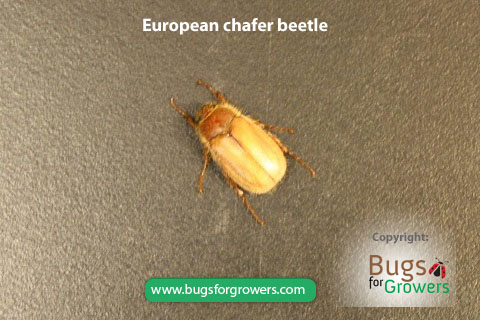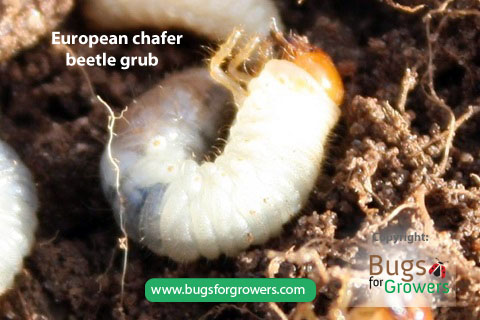Heterorhabditis bacteriophora are beneficial entomopathogenic nematodes that are effective against European chafer beetles
Description
European chafer beetles (Rhizotrogus majalis, Order: Coleoptera) are one of the most damaging pest of turfgrasses, horticultural (blueberries and strawberries) and field crops (corn, potatoes and small grains). Adult beetles are brownish in color and about 0.5 inch long (Photo 1). The mature larvae (grubs) of this beetle are “C” shaped, about 1.0 inch long, creamy white in color with brown/orange head capsule and three pairs (six) of strong legs (Photo 2).


Life cycle
European chafer beetles generally take one year to complete their life cycle. The life cycle of chafer beetle consists of four life stages such as eggs, larvae (grubs), pupae and adults. Adult beetles generally emerge in mid-June through early July from pupae every year. After emergence, they swarm in mating flights at warm dusk. After mating, each female lays about 50 eggs 4-5 inches deep in the cool and moist soil. These eggs hatch within 3-4 weeks into small larvae called grubs, which immediately starts feeding on the roots of turf grass and other host plants. While feeding grubs develop through three instars/stages that continue feeding until the ground freezes. Once soil starts freezing, grubs move deep in the soil for overwintering. These overwintering grubs do not feed during winter until soil begin thawing from March through April. In April, these grubs migrate near to the soil surface where they resume feeding on the host roots. While feeding grubs grow in large size, mature and then pupate in mid- May in the soil. After 3-4 weeks, the new generation adults start emerging from pupae and life cycle continues.
Damage
Although, the life cycle of European chafer beetle consists of eggs, larvae (grubs), pupae and adults, only grubs can feed and cause damage to turf grasses and other host plants. Adults do not feed on plants but they swarm in mating flights. After mating, females lay eggs in the soil. These eggs hatch in mid-July into first instar grubs that immediately start feeding on the roots of turf grass. These grubs continue feeding until soil begins freezing in November and during winter grubs stop feeding. These grubs resume feeding again in the spring when temperature rises. This feeding activity continues until grubs form pupae. European chafer grubs are cold tolerant and known to feed on roots of grass that is even covered under ice/snow. Severe turf damage is generally caused by the third stage grubs of European chafer beetles during both fall and spring seasons but it’s severity is masked by the presence of high soil moisture during these seasons. However, the severity of damage by this pest can be easily noticed when weather conditions are dry. The symptoms of damage by chafer grubs include brown and dying patches of turf grass throughout the golf courses and home lawns. The most important sign of presence of European chafer beetle grubs in the lawn is that the grub infested areas are destroyed by digging activity of animals such as raccoons and skunks that are looking for grubs to feast on them. Another sign of heavy infestation by European chafer grubs is that the infested grass in the lawn feels “spongy” due to tunneling activity of grubs underneath the turf grass.
Biological control
Use of chemical pesticides is generally restricted on the golf courses, home lawns and recreational parks due to their detrimental effects on humans, animals and environment. Therefore, beneficial entomopathogenic nematodes can serve as a safe and environment friendly alternative to pesticides in controlling European chafer beetles and maintaining the aesthetic value of golf courses and lawns. Beneficial entomopathogenic nematodes are insect parasitic nematodes that are currently used as effective biological control agents to control soil-dwelling pests of many agricultural and horticultural crops (For more information on entomopathogenic nematodes, please read the blog post entitled “Twelve important facts about beneficial entomopathogenic nematodes”). Among the several commercially available entomopathogenic nematodes, beneficial Heterorhabditis bacteriophora nematodes have been proved to be effective against European chafer beetle grubs. The best time to apply these beneficial nematodes is mid-July through early August because during this time both the first and second instar grubs are actively feeding on grass roots and these stages are known to be very susceptible to beneficial nematodes (Grewal et al., 2005; Koppenhofer et al., 2004). Beneficial entomopathogenic Heterorhabditis bacteriophora nematodes are very effective in killing young grubs of european Chafer beetles when they are applied at the rate of 23000 nematodes per square foot area between the middle of July and early August.
Research Papers
- Grewal, P.S., Koppenhofer, A.M., and Choo, H.Y., 2005. Lawn, turfgrass and Pasture applications. In: Nematodes As Biocontrol Agents. Grewal, P.S. Ehlers, R.-U., Shapiro-Ilan, D. (eds.). CAB publishing, CAB International, Oxon. Pp 147-166.
- Koppenhofer, A.M., Fuzy, E.M., Crocker, R.L., Gelernter, W.D. and Polavarapu, S. 2004. Pathogenicity of Heterorhabditis bacteriophora, Steinernema glaseri, and S. scarabaei (Rhabditida : Heterorhabditidae, Steinernematidae) against 12 white grub species (Coleoptera : Scarabaeidae). Biocontrol Science and Technology. 14: 87-92.
